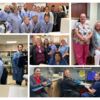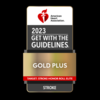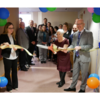Healing from an injury is a complex process that involves many steps, time and support from health care staff and loved ones. Mobility is an often overlooked and critical element in the healing process and it is one of the best predictors of health, longevity and quality of life.
Immobility is associated with adverse outcomes, including thromboembolic disease, joint contractures, atelectasis, skeletal muscle atrophy, weakness and pressure ulcers.
Nurses and health care staff use the Bedside Mobility Assessment Tool (BMAT) to determine a patient’s level of mobility and recommend proper equipment for safe patient transfers and movement.
“When a patient comes to the hospital, the care they receive is centered around the patient in the bed. Prolonged periods of time in bed compromise almost every body system. CAMC has begun intensive work around creating a culture of mobility, so our patients do not have to suffer the ill effects of immobility and they are ready for discharge home when they are medically stable,” said Leslie Johnson, Therapy Director. “On March 5, the Bedside Mobility Assessment Tool (BMAT) was introduced for nurses to assess patients’ daily functional ability during their hospital stay. The tool allows the staff to determine patient mobility status and choose safe patient handling equipment. It also has been validated and shown to reduce nursing injuries, reduce patient falls, improve nursing confidence in using mobility equipment and allow patients to get out of bed more often without relying on physical or occupational therapists.”
Mobility has become a focus in the Open Heart Recovery Unit at CAMC Memorial Hospital. Michael Ritchie, MD, has worked with staff on early mobility exercises and activities focusing on the first levels of the BMAT: sitting, shaking, stretching and pointing. Because strengthening is an essential aspect of mobility, Ritchie created his own band system to focus on strengthening exercises in bed.
“Mobility is so important for patients and it extends from before surgery to discharge and beyond,” Ritchie said. “It takes a team, including bedside nurses and therapists, to ensure that patients get the mobility they need every day. We created specialized resistance bands for the hospital bed and implemented walkers and cycles. We are able to improve the strength of all patients, bed bound to ambulatory and help them recover faster.”
At CAMC General Hospital, staff focus on the final two levels of the BMAT: standing and walking. The Leading by Example Mobility Team at General Hospital started “Walking Wednesdays.” This program offers clinical staff and administrators, after proper orientation, the opportunity to walk alongside patients. Rusty Martin, Associate Administrator, helps patients during “Walking Wednesdays” and has observed the gratitude patients express for the chance to be moving, noting the positive impact it has on patient experience.
“Walking Wednesdays has been an eye-opening experience for me,” Martin said. “Our first patient’s wife thanked us so much for giving her husband something else to do while he was in the hospital. Most patients are interested and willing to participate. It’s a great opportunity to make a positive impact in the patient’s hospital stay. I didn’t realize how spending a few minutes with patients one-on-one can mean so much. We were able to talk to patients, find out some of their concerns and get those concerns addressed to ease their worries.”
Through the healing process, mobility guides patients to recovery and well-being. Mobility is known to prevent complications as well as improve psychological resilience and patient care. By recognizing and prioritizing the importance of mobility, health care providers can enhance treatment outcomes and empower patients to reclaim their health, one step at a time.




